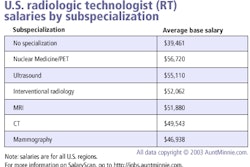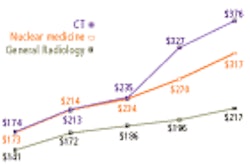
AuntMinnie.com is pleased to present part one of a two-part series on radiology coding and reimbursement tips by Coding Strategies Incorporated. If you have comments or questions, send them to [email protected].
By Melody W. Mulaik
Coding Strategies Incorporated

In addition to medical necessity concerns, physician documentation remains a key issue. The procedure and diagnosis codes submitted for payment must be supported in the patient’s medical record. For radiology services, the dictated radiology report should be the beginning and the end of the audit trail.
Documentation
When documenting radiology services, it is recommended that a separate report be created for each exam. If this is not practical, separate paragraphs should at least be included in the report to support the coding and billing of multiple exams. One way to approach documentation is what I like to call the black pen test. If you marked out everything related to one exam, what is left to defend the coding/billing of an additional exam?
Obviously, there will be many situations where the technique is best described in one paragraph, such as with CT abdomen and pelvis studies; however, the findings of the two exams can be separated into distinct paragraphs.
When an audit is conducted to evaluate correct procedure and diagnosis code assignment, the radiology report is the central document. The order for service is also important, and is generally included in an audit for independent diagnostic testing facilities (IDTFs) and physician offices. The radiology report should clearly indicate what type of procedure was performed on the patient and any modifying factors related to the study, such as the number and type of views or the use of IV contrast.
All radiology reports should contain the following elements (as applicable):
- Name of the patient and identifier
- Name of the referring physician
- Date and time of the radiology exam (especially important for inpatients)
- Comparative data, if available
- Signature of radiologist
- Patient clinical history
- Chronic conditions, previously established diagnoses, signs, symptoms, reason for exam
- Whether the test is a follow-up, and if so for what condition
- Pertinent positive and negative findings
- Impression and diagnosis, if known
- Include but do not use for diagnosis: incidental findings, probable, suspected, questionable
- Name or type of examination (technique)
- Limited, multiple areas, complete or whole body, unilateral or bilateral
- Number and type of views taken
- Type and amount of contrast media or radionuclide
- Number of sequences or slices, thickness and interval (when non-standard)
- With or without kidney-ureter-bladder (KUB), if applicable
- With or without duplex scan
- Single or multiple determinations
- Qualitative or quantitative (nuclear medicine)
- Multiplanar scanning and/or reconstruction
- Limitations (poor film, special patient prep)
- Recommendations for additional studies
For interventional radiology:
- Title of operation or procedure
- Detailed account of procedure including:
- Vascular access route(s)
- Each non-selective and selective vessel catheterized
- Any deviation from normal anatomy
- Performance of each procedure in the report heading
- Injections, including type and amount of contrast media
- Monitoring and sedation
- Complications (if any)
- Post-procedure patient status
- Findings, positive and negative
- Impression
For mammography services:
- Title of procedure: screening or diagnostic
- Based on the order by referring physician
- Change screening to diagnostic or bill both (according to payor guidelines) if:
- Screening mammogram ordered and performed
- Clinical findings documented and decision to perform additional views
- Impression documented after additional views
- Number and type of views
- Patient symptoms/complaints for diagnostic
OIG work plan
The 2003 Office of Inspector General (OIG) work plan specifically targets the inconsistencies between hospital outpatient services and physicians. Since many diagnostic and interventional radiology services are performed in hospitals on an outpatient basis, it is important that the current operational processes be evaluated to ensure that both entities are coding correctly based on documented services.
Additionally, the OIG 2003 work plan has targeted diagnostic testing performed on emergency room patients to evaluate the medical necessity of these procedures. This area of focus should be of concern to professionals involved in radiology, because we are performing requested services and have little control over modifying ER physician ordering practices in relation to medical necessity in these types of situations.
Bone density screening remains on the OIG’s work plan to ensure that medical necessity criteria are being met for services paid by Medicare. A new edition to this year’s OIG work plan is a focus on evaluating the enforcement of unbundling guidelines through the Correct Coding Initiative (CCI).
Specifically, the OIG stated that it will "test whether carriers are appropriately applying edits required for Medicare CCI. The initiative, one of Medicare’s tools for detecting and correcting improper billing, is designed to provide Part B with code pairs for use in reviewing claims. We will determine whether physicians were improperly paid for claims that should have been rejected based on the coding initiative (i.e., use of modifier -59)."
Advance beneficiary notices
In order to bill a Medicare beneficiary for a service that has been deemed as "not medically necessary" by Medicare, the provider must properly inform the patient of this designation before the service is rendered. A written notice, referred to as an advance beneficiary notice (ABN), must be provided to a Medicare beneficiary before services are furnished when the provider believes that Medicare will not pay for some or all of the services on the basis that they are not reasonable and necessary.
The ABN must identify the service or item for which denial is expected and clearly state the reason a Medicare denial is expected. The ABN may include an estimate of the cost.
The patient should be given a copy of the signed ABN. Because each ABN is procedure and date specific, the patient should never sign a blank ABN.
If your organization does not currently utilize ABNs, Medicare patients may never be billed for services not paid due to medical necessity. If ABNs are utilized, it is important that the appropriate guidelines be followed. The most common medical necessity guidelines for diagnostic radiology include magnetic resonance angiography and PET scans, and the incorporation of ABNs could potentially decrease account write-offs and increase patient revenues. Additional information can be found at: http://www.cms.hhs.gov/medicare/bni.
Radiology orders
Effective January 1, 1997, diagnostic testing, including diagnostic x-ray, became covered by Medicare only when ordered by the physician who treats the patient. This restriction does not apply to diagnostic tests furnished in hospitals. Hospital diagnostic studies are governed by two separate provisions, and in those regulations there is no statement restricting ordering authority to treating physicians.
On September 27, 2001, the Centers for Medicare and Medicaid Services (CMS) released Transmittal #1725, which provides additional clarification regarding the ordering of diagnostic tests. According to CMS, an "order" is a communication from the treatment physician/practitioner requesting that a diagnostic test be performed for a beneficiary.
The order may conditionally request an additional diagnostic test if the result of the initial diagnostic test ordered yields a certain value determined by the treating physician (for example, if diagnostic mammogram is positive, perform an ultrasound if clinically indicated). An order may include the following forms of communication:
- A written document signed by the treating physician, which is hand-delivered, mailed, or faxed to the testing facility;
- A telephone call by the treating physician or his/her office to the testing facility; and
- An electronic mail by the treating physician or his/her office to the testing facility.
If the order is communicated via telephone, both the treating physician, or his/her office, and the testing facility must document the telephone call in their respective copies of the beneficiary’s medical records.
Additional revisions to Section 15021 in the Medicare Carriers Manual (MCM) are as follows:
"The treating physician/practitioner must order all diagnostic tests furnished to a beneficiary who is not an institutional inpatient or outpatient. A testing facility that furnishes a diagnostic test ordered by the treating physician/practitioner may not change the diagnostic test or perform an additional diagnostic test without a new order." This policy is intended to prevent the practice of some testing facilities to routinely apply protocols, which require performance of sequential tests.
When the radiologist at a testing facility determines that an ordered diagnostic radiology test is clinically inappropriate or suboptimal and that a different diagnostic test should be performed (for example, an MRI should be performed instead of a CT scan because of the clinical indication), the radiologist/testing facility may not perform the unordered test until a new order from the treating physician/practitioner has been received.
Similarly, if the result of an ordered diagnostic test is normal and the radiologist believes that another diagnostic test should be performed (for example, a renal sonogram was normal and based on the clinical information, the radiologist believes an MRI will reveal the diagnosis), an order from the treating physician must be received prior to performing the unordered diagnostic test.
If the testing facility cannot reach the treating physician/practitioner to change the order or obtain a new order, and the facility documents this in the medical record, then the testing facility may furnish the additional diagnostic test if all of the following criteria apply:
- The testing center performs the diagnostic test ordered by the treating physician/practitioner;
- The radiologist at the testing facility determines and documents that, because of the abnormal result of the diagnostic test performed, an additional diagnostic test is medically necessary;
- Delaying the performance of an additional diagnostic test would have an adverse effect on the care of the beneficiary;
- The result of the test is communicated to and is used by the treating physician/practitioner in the treatment of the beneficiary; and
- The radiologist at the testing facility documents in his/her report why additional testing was done.
Example: (a) the last cut of an abdominal CT scan with contrast shows a mass requiring a pelvic CT scan to further delineate the mass; (b) a bone scan reveals a lesion on the femur requiring plain films to make a diagnosis.
A radiologist exception exists which applies to a radiologist of a testing facility who furnishes a diagnostic test to a beneficiary who is not a hospital inpatient or outpatient. The radiologist must document accordingly in his/her report to the treating physician/practitioner.
Test Design. Unless specified in the order, the radiologist may determine, without notifying the treating physician/practitioner, the parameters of the diagnostic test (for example, number of radiographic views obtained, thickness of tomographic sections acquired, use or non-use of contrast media).
Clear Error. The radiologist may modify, without notifying the treating physician/practitioner, an order with clear and obvious errors that would be apparent to a reasonable layperson, such as the patient receiving the test (for example, x-ray of the wrong foot ordered).
Patient Condition. The radiologist may cancel, without notifying the treating physician/practitioner, an order because the beneficiary’s physical condition at the time of diagnostic testing will not permit performance of the test (for example, a barium enema cannot be performed because of residual stool in colon on scout KUB; PA/LAT of the chest cannot be performed because patient is unable to stand). When an ordered diagnostic test is cancelled, any medically necessary preliminary or scout testing performed is payable.
Radiology orders
Unbundling is defined as the billing of multiple procedure codes for a group of procedures that are covered by a single comprehensive code. There are two types of unbundling: unintentional, resulting from a misunderstanding of coding; and intentional, when an entity manipulates coding in order to maximize payment.
The following are some examples of unbundling:
- Coding component parts of a procedure with separate CPT codes;
- Reporting separate codes for related services when the code for the primary procedure includes all related services;
- Coding a unilateral service twice instead of coding the one bilateral code;
- Downcoding a service in order to use an additional code when a single higher-level, more comprehensive code is appropriate;
- Separating a surgical approach from the major surgical service.
Mutually exclusive procedures are those that generally cannot be performed during the same session.
Not all payors utilize the National Correct Coding Policy (NCCP) developed for the CMS. Many third-party commercial payors utilize ClaimCheck or other rebundling software. As a result, services that may be considered separately payable by some payors could be "bundled" by other payors.
Unbundling issues frequently appear in radiology in the following NCCP directives:
- Due to patient variations, studies that require contrast do not have an established number of radiographs to be obtained. Therefore, all radiographs necessary to complete the study are included in the descriptor of the CPT code.
- Effective January 1, 1998, CPT code 99141 (sedation with or without analgesia (conscious sedation); intravenous, intramuscular or inhalation) and 99142 (sedation with or without analgesia; oral, rectal, and/or intranasal) have been assigned a status (B), or bundled, on the Medicare Fee Schedule Data Base (MFSDB). Therefore this code should not be submitted for Medicare patients. Many other third-party payors follow Medicare guidelines for conscious sedation bundling; individual payor policy takes precedence.
- Unless specifically noted, fluoroscopy required to complete a radiology procedure and obtain the necessary permanent radiographic record is included in the major procedure performed.
- Scout films obtained prior to imaging studies with contrast or delayed images are considered to be included in the basic procedure.
- The injection of radionuclide is considered part of the nuclear medicine procedure.
- Bone age studies require a series of radiographs; billing separately for bone age studies and individual radiographs obtained in the course of the bone age study is inappropriate.
- Contrast administered orally or rectally is included as part of the procedure and no administration service is reported.
- The administration and injection are included in the contrast studies when contrast is administered parenterally, whether the timing of the injection has to correlate with the procedure or not (IVP, CT, and so on).
AuntMinnie.com contributing writer
October 30, 2003
Melody Mulaik is president of Coding Strategies Incorporated. Her company will present its comprehensive radiology-only workshop networking (CROWN) seminar for diagnostic radiology on November 3-6 in Chicago, November 17-20 in Philadelphia, and December 8-11 in San Antonio, TX. The company can be contacted at 877-626-3464, or via its Web site at www.codingstrategies.com, for further information.
Next installment, Part II: Modality-specific coding, documentation concerns and operational processes.
Related Reading
Demystifying the internal auditing program, October 16, 2002
Coding changes on tap for October 1, 2002, July 16, 2002
Do you know who is minding the codes? March 27, 2002
Necessity criteria compliance critical for PET reimbursement, February 28, 2002
New Year brings new coding and bundling changes, January 18, 2002
Copyright © 2003 Coding Strategies Incorporated



















